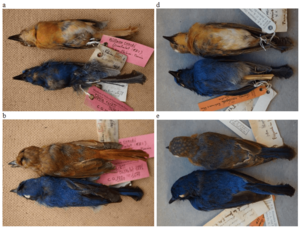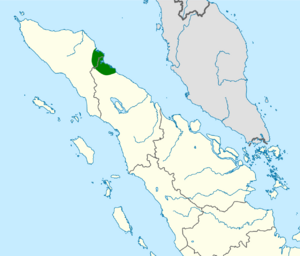Rück's blue flycatcher facts for kids
Quick facts for kids Rück's blue flycatcher |
|
|---|---|
 |
|
| Left side: An adult female (a) and an adult male (b). Right side: An immature male (d) and an adult male (e). | |
| Conservation status | |
| Scientific classification | |
| Genus: |
Cyornis
|
| Species: |
ruckii
|
 |
|
| Where C. Ruckii lives | |
| Synonyms | |
|
|
The Rück's blue flycatcher (Cyornis ruckii) is a small bird in the Muscicapidae family, also known as Old World flycatchers. This bird is very rare. Only four of these birds have ever been found. They live only in a small part of northeast Sumatra, Indonesia. They prefer to live in old, untouched lowland forests.
All the found birds share some features. They all have a black beak, brown eyes, and black feet. However, two of the birds looked a bit different from the other two. These two were first thought to be a new species called Cyornis vanheysti. Later, scientists agreed they were also Rück's blue flycatchers. This bird has also been compared to other Cyornis species.
The International Union for Conservation of Nature (IUCN) lists this bird as "Critically Endangered". This means it is at a very high risk of disappearing forever. The last time anyone saw this bird was in 1918. Indonesian law has protected it since 1972. It might also have been affected by the 2004 Indian Ocean tsunami.
Contents
How Scientists Classify This Bird
Rück's blue flycatcher was first described by a French zoologist named Émile Oustalet. He studied two birds, an adult male and an adult female, in 1881. These birds were sent to him from a trading port in Malaysia. Oustalet named the species after the person who sent them, Monsieur Rück. He gave it the scientific name Cyornis ruckii. Sometimes, people spell it Cyornis rueckii, but this is not the correct spelling.
Two more birds were found in 1917 and 1918 near Medan, Indonesia. British zoologists Herbert Robinson and Cecil Kloss studied these birds. They first thought these were a new species, Cyornis vanheysti. But they also noticed how similar they were to the birds Oustalet described. Eventually, they agreed that C. vanheysti was the same as C. ruckii. These two birds are now kept at the American Museum of Natural History.
Scientists have also wondered if Rück's blue flycatcher was just a different form of the pale blue flycatcher (Cyornis unicolor). But when they compared them, they found clear differences. The pale blue flycatcher looks different in color and body shape. Rück's blue flycatcher is a monotypic species. This means it is the only species in its group.
What Rück's Blue Flycatcher Looks Like
Rück's blue flycatcher is about 17 cm (6.7 in) long. It has a black beak, brown eyes, and black feet. There are some differences between the birds Oustalet described and those Robinson & Kloss described.
In the birds Oustalet studied, the male had dark blue feathers. Its belly was blue, and its lower back (rump) was a shiny blue. It also had a little grey on the feathers around its legs. The female had reddish-brown feathers. It had strong reddish-orange markings around its eyes (lores) and a reddish-orange chest. Its belly was whitish.
In the birds Robinson & Kloss studied, the young male had buff-colored feathers with brown spots. It had a reddish chest and a whitish center on its underside. The adult male looked a bit different from Oustalet's adult male. Its belly and feathers under its tail were whitish-grey. Its sides (flanks) were bluish-grey. Also, the birds found by Robinson & Kloss had slightly larger beaks. These differences might be because individual birds can vary. Or, they could be from different groups within the species.
Where This Bird Lives and Its Home
Rück's blue flycatcher lives only in Sumatra, Indonesia. It is found around the city of Medan. Scientists believe there are very few of these birds left. The birds found by Rück lived in old, untouched lowland forests. The birds found by van Heyst were thought to be from forests that had been used by people. This might mean the bird can live in areas where its home has been changed. However, some scientists disagree with this idea.
Protecting This Rare Bird
The last time anyone saw a Rück's blue flycatcher was in 1918. Because its home is being lost, and because there haven't been many surveys, this bird is listed as "Critically Endangered". This is on the IUCN Red List, which tracks species at risk. It is also listed in Appendix II of CITES. This means it is protected from international trade. Indonesian law has protected it since 1972.
In 2013 and 2014, some birds were seen in Jambi, Sumatra. They looked like Rück's blue flycatchers. But scientists could not be sure if they were actually white-tailed flycatchers (Cyornis concretus). The Rück's blue flycatcher might have been affected by the 2004 Indian Ocean tsunami. Scientists also predict there is an 80% chance that this bird is now extinct.


